2020年中考英语专题复习——非谓语动词 课件(48张PPT)
文档属性
| 名称 | 2020年中考英语专题复习——非谓语动词 课件(48张PPT) |  | |
| 格式 | ppt | ||
| 文件大小 | 2.3MB | ||
| 资源类型 | 教案 | ||
| 版本资源 | 通用版 | ||
| 科目 | 英语 | ||
| 更新时间 | 2020-07-05 11:25:01 | ||
图片预览

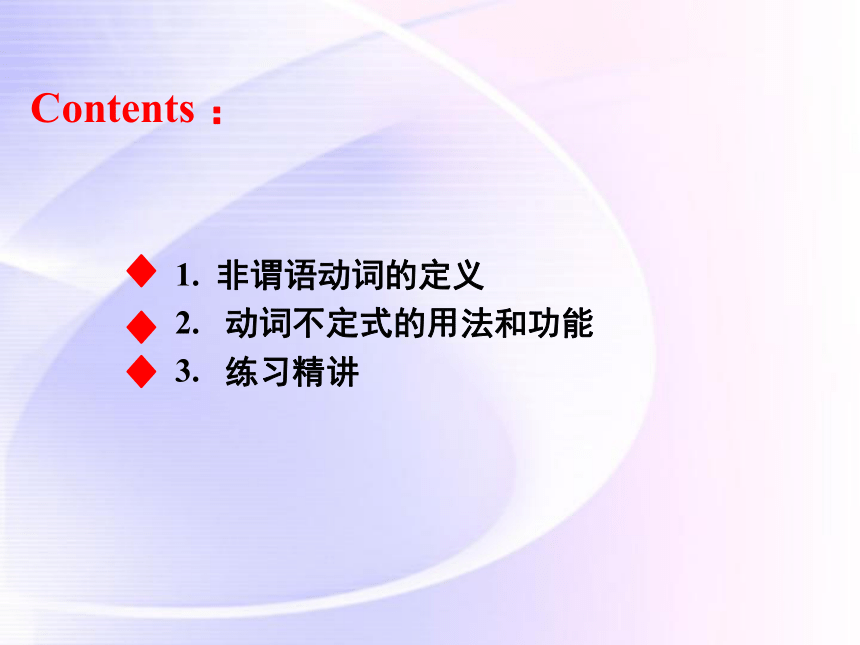


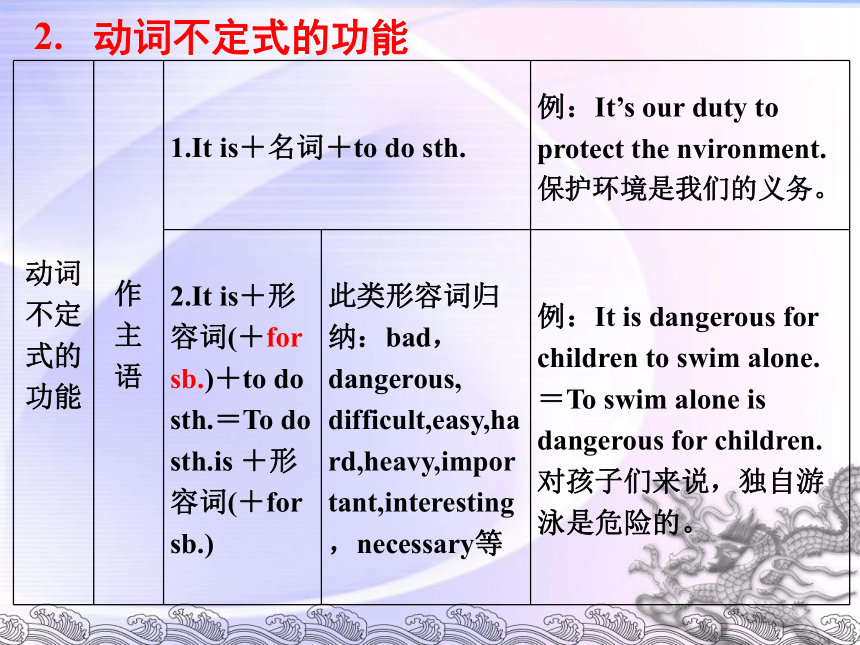
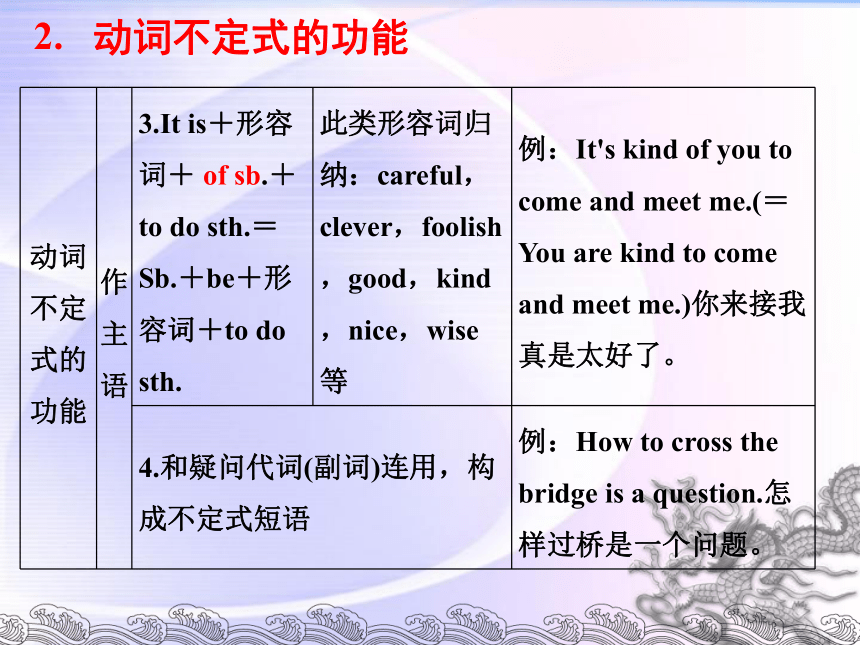


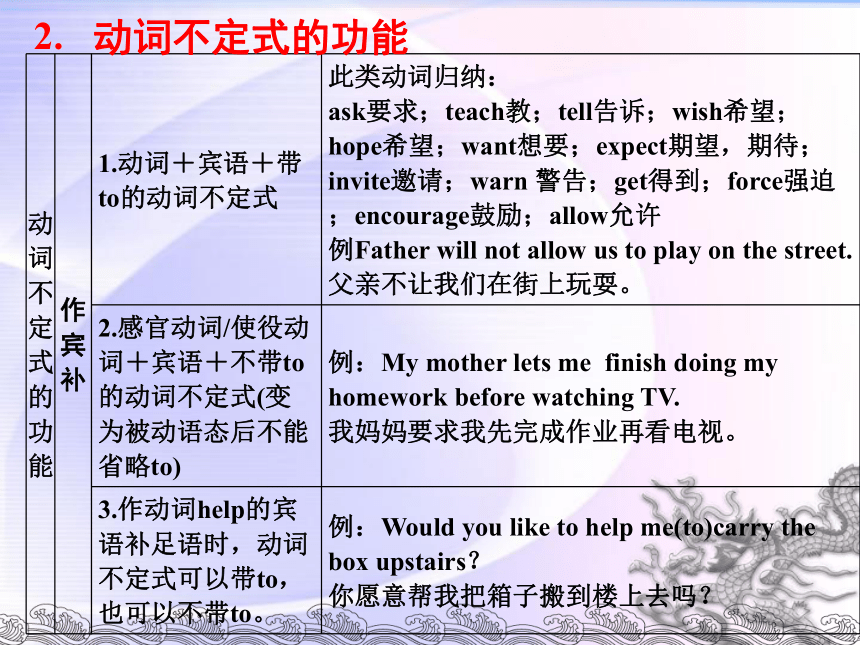
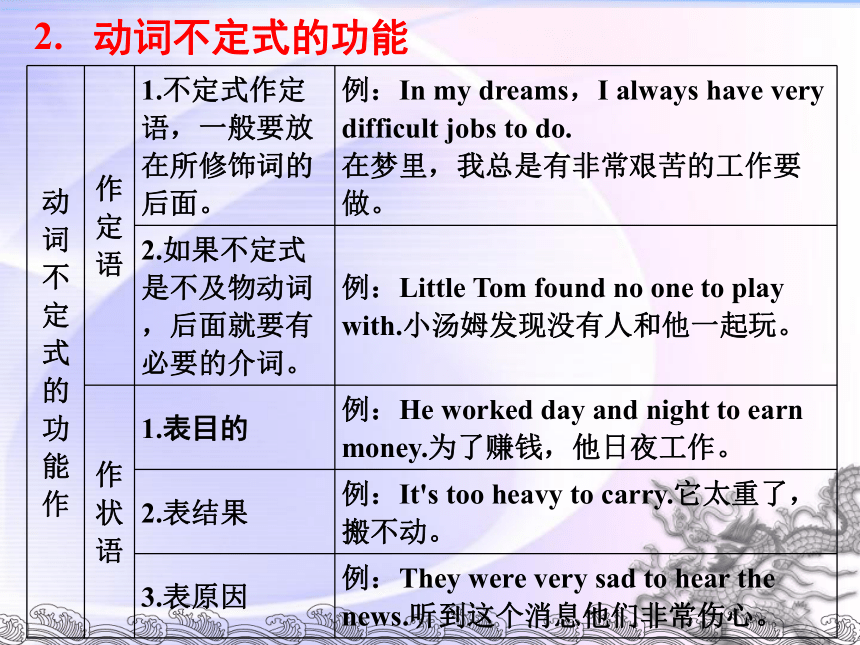
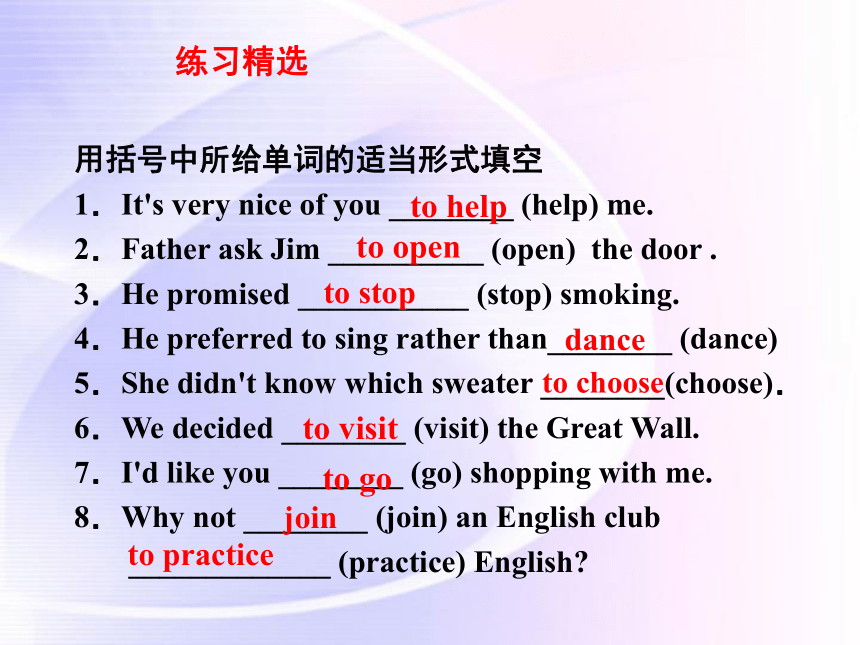

文档简介
中考专题复习
非谓语动词一(动词不定式)
1. 非谓语动词的定义
2. 动词不定式的用法和功能
3. 练习精讲
Contents :
非谓语动词,又叫非限定动词,非 谓语动词是指在句子中不是谓语的动词,非谓语动词除了不能独立作谓语外,但可以承担句子的其他很多成分。
主要包括?:
一、动词不定式
二、动名词
三、分词( 现在分词和过去分词)。
1.非谓语动词的定义
不定式有两种,即带to的不定式(to+动词原形)和不带to的不定式。注意:它没有人称和数的变化。
2. 动词不定式的功能
动词不定式的功能
作主语
1.It is+名词+to do sth.
例:It’s our duty to protect the nvironment.保护环境是我们的义务。
2.It is+形容词(+for sb.)+to do sth.=To do sth.is +形容词(+for sb.)
此类形容词归纳:bad,dangerous, difficult,easy,hard,heavy,important,interesting,necessary等
例:It is dangerous for children to swim alone. =To swim alone is dangerous for children.
对孩子们来说,独自游泳是危险的。
2. 动词不定式的功能
动词不定式的功能
作主语
3.It is+形容词+ of sb.+to do sth.=Sb.+be+形容词+to do sth.
此类形容词归纳:careful,clever,foolish,good,kind,nice,wise等
例:It's kind of you to come and meet me.(=You are kind to come and meet me.)你来接我真是太好了。
4.和疑问代词(副词)连用,构成不定式短语
例:How to cross the bridge is a question.怎样过桥是一个问题。
2. 动词不定式的功能
动词不定式的功能
作宾语
1.动词+带to的动词不定式
通常只能接不定式作宾语的动词归类:
afford 买得起;agree 同意;offer提出;intend计划,打算;plan计划;ask要求;promise答应;prepare准备;decide决定refuse拒绝;choose选择;wish希望;hope希望;want想要;expect期望,期待;fail不能;manage 设法;learn学习
例:I decided to go to the countryside on vacation.我决定去农村度假。
2.动词+疑问词+带to的动词不定式
此类动词归纳:
know知道;decide决定;ask要求;forget忘记;get得到;remember记住;understand理解;wonder想知道;tell告诉
例:I don't know what to do next.我不知道接下来要做什么。
2. 动词不定式的功能
动词不定式的功能
作宾语
3.主语+动词+it+形容词+不定式
此类动词归纳:
feel感觉;believe相信;find发现;make制作;think认为
例:I find it easy to learn English well.我发现学好英语很容易。
作表语※
多数情况下,不定式作表语,可转换为作主语
例:Her dream is to be an actress.(=To be an actress is her dream.)
2. 动词不定式的功能
动词不定式的功能
作宾补
1.动词+宾语+带to的动词不定式
此类动词归纳:
ask要求;teach教;tell告诉;wish希望;hope希望;want想要;expect期望,期待;invite邀请;warn 警告;get得到;force强迫;encourage鼓励;allow允许
例Father will not allow us to play on the street.
父亲不让我们在街上玩耍。
2.感官动词/使役动词+宾语+不带to的动词不定式(变为被动语态后不能省略to)
例:My mother lets me finish doing my homework before watching TV.
我妈妈要求我先完成作业再看电视。
3.作动词help的宾语补足语时,动词不定式可以带to,也可以不带to。
例:Would you like to help me(to)carry the box upstairs?
你愿意帮我把箱子搬到楼上去吗?
2. 动词不定式的功能
动词不定式的功能作
作定语
1.不定式作定语,一般要放在所修饰词的后面。
例:In my dreams,I always have very difficult jobs to do.
在梦里,我总是有非常艰苦的工作要做。
2.如果不定式是不及物动词,后面就要有必要的介词。
例:Little Tom found no one to play with.小汤姆发现没有人和他一起玩。
作状语
1.表目的
例:He worked day and night to earn money.为了赚钱,他日夜工作。
2.表结果
例:It's too heavy to carry.它太重了,搬不动。
3.表原因
例:They were very sad to hear the news.听到这个消息他们非常伤心。
2. 动词不定式的功能
用括号中所给单词的适当形式填空
1.It's very nice of you ________ (help) me.
2.Father ask Jim __________ (open) the door .
3.He promised ___________ (stop) smoking.
4.He preferred to sing rather than________ (dance)
5.She didn't know which sweater ________(choose).
6.We decided ________ (visit) the Great Wall.
7.I'd like you ________ (go) shopping with me.
8.Why not ________ (join) an English club
_____________ (practice) English?
练习精选
to help
to open
to stop
dance
to choose
to visit
to go
join
to practice
9.I find it easy ________ (learn) English well.
10.Do you have anything ________ (eat).
11.I come here only __________ (borrow) a book
from you.
12.John is too young ________ (go) to school .
13.My suggestion is for you ________(talk) to him.
14.She eats less so as ________ (keep ) thinner.
15.I’m sorry to hit you , I didn’t _____________
(mean).
to learn
to eat
to borrow
to go
to talk
to keep
mean to
中考专题复习
非谓语动词二(动名词)
1.动名词的用法和功能
2.练习精讲
Contents :
动名词的功能
作主语
谓语动词用单数
例:Eating too much is bad for your health.
吃太多不利于你的健康。
作表语
动名词作表语主要是对主语内容的进一步说明和解释
例:My job is helping others.我的工作是帮助他
人。
作宾语
作动词或介词的宾语,表示一般的习惯,抽象行为或者经常性的动作
例:Have you finished reading the book?
你读完这本书了吗?
I look forward to hearing from you.我期待着你的来信
作定语
动名词作定语,说明被修饰词的性质、特征或用途。
?
例:He may be in the reading room.
他可能在阅览室里。
They set up an operating table.
他们搭起一个手术台。
1.动名词的用法
只能接动名词的动词或短语
be afraid of doing sth.害怕做某事 be used to doing sth.习惯于做某事
have no difficulty(in)doing sth.做某事没有困难 imagine doing sth.想象做某事
consider doing sth.考虑做某事 avoid doing sth.避免做某事
give up doing sth.放弃做某事 have fun doing sth.玩得开心
practise doing sth.练习做某事 make a contribution to doing sth.为做某事做贡献
look forward to doing sth.盼望做某事 be worth doing sth.值得做某事
enjoy doing sth.喜欢做某事 keep doing sth.一直做某事
suggest doing sth.建议做某事 finish doing sth.做完某事
feel like doing sth.想要做某事 spend time(in)doing sth.花费时间做某事
can't help doing sth.情不自禁做某事 mind doing sth.介意做某事 miss doing sth.错过做某事
既可接不定式又可接动名词的动词
remember doing sth.记得做过某事 remember to do sth.记得去做某事(未做)
forget doing sth.忘了做过某事 forget to do sth.忘了去做某事(未做)
regret doing sth.后悔做过某事 regret to do sth.遗憾要做某事
stop doing sth.停止做某事 stop to do sth.停下来去做某事
try doing sth.尝试做某事 try to do sth.尽力做某事
go on doing sth.继续不停地做某事 go on to do sth.(做完一件事)接着去做另外一件事
中考专题复习
非谓语动词三(分词)
1.分词的分类
2.分词的用法和功能
3. 练习精讲
Contents :
分词分为现在分词和过去分词两种。现在分词(v.?ing)有主动、进行之意;过去分词(v.?ed)有被动、完成之意。它在句子中可作表语、宾语补足语、定语和状语。
分词的分类
分词的功能
作表语
现在分词用来说明事物
amazing(令人惊讶的 )
boring( 使人生厌的 )
disappointing(令人失望的 )
surprising( 令人惊异的)
interesting(有趣的)
过去分词用来说明人
amazed(感到惊讶的 )
bored(感到厌烦的)
disappointed(感到失望的)
surprised(感到惊异的)
interested(感到有趣的)
The story is interesting.
I am interested in the story.
作宾语补足语
现在分词用来说明宾语主动或正在做什么
see,watch,hear,feel,find,notice, keep +sb/sth doing …
过去分词用来说明宾语被怎样了
make sth/sb done
have sth/sb done
get sb/sth done
He kept him waiting for a long time.
I saw a girl boating on the lake.
She spoke slowly to make herself heard.
I had my pen repaired just now.
作定语
现在分词做定语表主动和正在。
a sleeping baby, a flying plane, boiling water ,the animal living in the forest
过去分词做定语表被动或已经完成。
the broken window
the boiled water
a boy named Tom
a book written by Mark Twain
分词的功能
作状语
现在分词用来说明主动或进行
表时间,结果,原因,伴随,条件,让步,行为方式等
过去分词用来说明被动或完成
表时间,结果,原因,伴随,条件,让步,行为方式等
1.Although working very hard, he failed to pass the final exam.
(表让步)
2.When leaving the airport, she waved again and again to us .
(表时间)
3.My cousin went to Shenzhen, hoping to find a job there. (表伴随)
4.The child fell, striking his head against the door. (表结果)
5.Being spring, the flowers are in full bloom.(表原因)
6.Working hard, you will succeed. (表条件)
7.He earns living driving a truck.(表方式)
分词的功能
作状语
现在分词用来说明主动或进行
表时间,结果,原因,伴随,条件,让步,行为方式等
过去分词用来说明被动或完成
表时间,结果,原因,伴随,条件,让步,行为方式等
1.Born in a poor family, Nadia had only two years of schooling.
(表原因)
2.When asked her future plans, the girl said she wanted to be
a teacher. (表时间)
3.Some medicines, if wrongly taken, can kill a person. (表条件)
4.Encouraged by his parents, he still has no confidence in overcoming
the difficulties. (表让步)
5.The patient got off the bed, supported by the nurse. (表方式)
6.The girl met with an accident, wounded in the head.(表结果)
练习
Thanks for listening !
4.分词的用法
分词分为现在分词和过去分词两种。现在分词(v.?ing)有主动、进行之意;过去分词(v.?ed)有被动、完成之意。
1.作定语
China is a ____________ country. America is a _________
country.中国是一个发展中国家,美国是一个发达国家。
I know the boy called Li Ming.
我认识那个叫李明的男孩。
2.作表语
The book is interesting. I'm interested in it.
这本书很有趣,我对它感兴趣。
developing
developed
3.作宾语补足语
I saw her going upstairs.我看见她正在上楼。
I want to have some photos taken. 我想拍几张照片。
4.作状语
Laughing and talking, they went into the room.
他们有说有笑地走进了房间。
5.现在分词与过去分词的区别
(1)在语态上,现在分词表示主动,过去分词表示被动。
the surprising news 令人惊讶的新闻
a surprised look 惊讶的神色
(2)在时间上,现在分词表示正在进行的动作,过去分词表
示已经完成的动作。
the developing country 发展中国家
the developed country 发达国家
6.易混结构
[注意] (1)在“make+宾语+过去分词”结构中,过去分词的动词必须是表示结果含义的。
I tried to speak more clearly so that I could make myself understood.
我尽量说清楚些,以便让别人明白我。
(2)have sth . done 意为“让某人做某事”,相当于ask sb. to do sth., done 表示让他人完成,有被动之意。
I had my computer repaired yesterday.
昨天我让人修理了我的电脑。
用括号中所给单词的适当形式填空
1.It's very nice of you ________ (help) me.
2.He's interested in ________ (play) chess.
3.Please stop ________ (smoke). It's bad for your health.
4.The kids had fun ____________ (swim) in the water.
5.She didn't know which sweater ________(choose).
6.We decided ________ (visit) the Great Wall.
7.I'd like you ________ (go) shopping with me.
8.Why not ________ (join) an English club to practice ______________ (speak) English?
考点过关训练
to help
playing
smoking
swimming
to choose
to visit
to go
join
speaking
9.As we all know, it's impolite to keep others ________ (wait) for a long time.
10.My computer doesn't work. I must have it ________ (repair).
11.They spent two hours ________ (clean) the house.
12.John used to ________ up late, but now he's used to ________ up early.(get)
13.Would you mind ________(turn) down the music? The baby is sleeping.
14.Students in our class have finished ________ (read) the article.
15.Our teacher has given us some advice that is well worth _____________ (consider).
considering
waiting
repaired
cleaning
get
getting
turning
reading
16.She raised her voice to make herself ________(hear).
17.—What is he busy doing?
—He is busy doing the experiment ____________(complete) the science project.
18.To reduce air pollution, we'd better ride more often instead of ________ (drive).
19.—Do you still remember ________(see) me somewhere in Beijing?
—Yes, of course. Two years ago.
20.Lost in Thailand is a Chinese comedy ________ (direct) by Xu Zheng.
语法互动(十)┃ 非谓语动词
directed
heard
to complete
driving
seeing
【考点即练】
1.It takes me two hours _________(找到)your new house.
2.The teacher left the classroom without _________(说;讲)anything.
3.Last summer,I took a lesson on how _________(制作)dresses.
4.That box is too heavy for me _________(搬运).
5.After long years of war,many people in Syria are homeless.I think it important _________(建立)a peaceful world.
6.Students should learn some ways _________(节约)energy at home.
7.Some people enjoy _________ (发出) out their messages in bottles when they travel on the sea.
to find
saying
to make
to carry
to build
to save
sending
【考点即练】
1.It's time for class.All the children stopped _______(talk).
2.The film is worth _________(see)twice.
3.Their work is _________ the streets,but _________ up the city makes them proud.(clean)
4.—Did he enjoy _________(work)in China?
—Sure, he could practise _________(speak)Chinese with his workmates often.
5.A dog was found _________(lie)on the ground.
talking
seeing
to clean
cleaning
working
speaking
lying
不定式有两种,即带to的不定式(to+动词原形)和不带to的不定式。注意:它没有人称和数的变化。
1.作主语[常用it作形式主语,而将真正的主语(动词不定式)置于句末。]
常用句型结构为“It's+adj./n.+(for/of sb.)+to do sth.”。
To ask the teacher for help is necessary.
=It is necessary to ask the teacher for help.
向老师寻求帮助是必要的。
2. 动词不定式的用法
2.作宾语
(1)后接不定式作宾语的动词有 want, try, decide, hope, need, wish, agree, expect, refuse, learn, remember, forget, would like/love等。
I hope __________ there before dark.
我希望天黑以前到那儿。
(2)在think, find, make等动词后通常用it作形式宾语,而将不定式移至形容词之后,构成“主语+谓语+it(形式宾语)+宾补(形容词/名词)+不定式”结构。
I found it difficult to solve the problem.
我发现解决这个问题很难。
to get
3.作宾语补足语
(1)后面能接带to的不定式作宾补的动词有 tell,
ask, allow, want, help, wish, teach, warn, invite, would like, encourage等。
The teacher told us __________ Exercise 1.
老师告诉我们做练习一。
(2)使役动词let, make, have和感官动词see,hear, watch, notice, feel等后要用不带to的动词不定式作宾补。但是,当上述动词变为被动语态时,其后的不定式必须补上to。
We often hear her sing. 我们经常听见她唱歌。
被动语态: She is often heard to sing.
to do
4.作状语
常见的状语有目的状语、原因状语、结果状语等。
Mr. Lee will go to Hangzhou to visit the West Lake. 李先生将会去杭州参观西湖。(作目的状语)
5.作定语
动词不定式作定语时,放在被修饰的名词的后面,作后置定语。若不定式结构中的动词是不及物动词,且与所修饰的词之间有动宾关系,则不定式后面要加上适当的介词。
I don't have a partner to practice English with.
我没有一个一起练习英语的同伴。
I had to find a place to live in.
我不得不找一个住的地方。
6.作表语
Their duty is ________________________ the animals.
他们的职责是照看动物。
7. “疑问词+不定式”结构
动词不定式可以和what, which, when, where, how等疑问词连用,构成不定式短语,在句中作主语、宾语、表语、宾语补足语等。
He doesn't know ________________.
他不知道要穿什么。(作宾语)
[提醒] 动词不定式的否定结构为“not to do sth.”。
to look after/take care of
what to wear
语法互动(十)┃ 非谓语动词
动名词由“动词原形+?ing”构成,其与现在分词同形。动名词既有动词的性质,也有名词的性质。
1.作主语
Playing computer games too much is bad for your eyes.过度地玩电脑游戏对你的眼睛有害。
动名词作主语和动词不定式作主语,在很多情况下可以通用。
3.动名词的用法
2.作宾语
常接动名词作宾语的动词或短语有 enjoy, finish, consider(考虑), miss, keep, mind, practice, suggest, be busy, feel like, give up, can't help, avoid, be used to, be worth, be afraid of, be proud of, be interested in, can't stop, keep/stop…from, look forward to, put off, have fun等。
Have you finished __________ the book?
你读完这本书了吗?
reading
3.作表语
The nurse's job is _________________________ the patients.
护士的工作是照顾病人。
4.作定语
I often go to the _____________.
我经常去阅览室。
looking after/taking care of
reading room
[提醒] 有些词后既可接不定式又可接v.?ing形式作宾语,但表达的意义不同。常见短语:
(1)stop to do sth.停下来去做另外一件事(不定式作目的状语)
stop doing sth.停止做某事(v.?ing作宾语)
(2)try to do sth. 试图(企图)做某事;尽力做某事
try doing sth.尝试着做某事
(3)forget to do sth.忘记要去做某事(还没做)
forget doing sth.忘记做过了某事(已做)
(4)remember to do sth.记着要去做某事(还没做)
remember doing sth.记得做过了某事(已做)
(5)go on to do sth.做完一件事后继续做另外一件不同的事
go on doing sth.继续做原来所做的事
(6)sth. need doing(某事)需要做(被动含义)
need to do sth. 需要去做某事(主动含义)
(7)regret to do sth.对要做的事感到遗憾(未做)
regret doing sth. 对做过的事感到遗憾、后悔(已做)
4.分词的用法
分词分为现在分词和过去分词两种。现在分词(v.?ing)有主动、进行之意;过去分词(v.?ed)有被动、完成之意。
1.作定语
China is a ____________ country. America is a _________
country.中国是一个发展中国家,美国是一个发达国家。
I know the boy called Li Ming.
我认识那个叫李明的男孩。
2.作表语
The book is interesting. I'm interested in it.
这本书很有趣,我对它感兴趣。
developing
developed
3.作宾语补足语
I saw her going upstairs.我看见她正在上楼。
I want to have some photos taken. 我想拍几张照片。
4.作状语
Laughing and talking, they went into the room.
他们有说有笑地走进了房间。
5.现在分词与过去分词的区别
(1)在语态上,现在分词表示主动,过去分词表示被动。
the surprising news 令人惊讶的新闻
a surprised look 惊讶的神色
(2)在时间上,现在分词表示正在进行的动作,过去分词表
示已经完成的动作。
the developing country 发展中国家
the developed country 发达国家
6.易混结构
[注意] (1)在“make+宾语+过去分词”结构中,过去分词的动词必须是表示结果含义的。
I tried to speak more clearly so that I could make myself understood.
我尽量说清楚些,以便让别人明白我。
(2)have sth . done 意为“让某人做某事”,相当于ask sb. to do sth., done 表示让他人完成,有被动之意。
I had my computer repaired yesterday.
昨天我让人修理了我的电脑。
非谓语动词一(动词不定式)
1. 非谓语动词的定义
2. 动词不定式的用法和功能
3. 练习精讲
Contents :
非谓语动词,又叫非限定动词,非 谓语动词是指在句子中不是谓语的动词,非谓语动词除了不能独立作谓语外,但可以承担句子的其他很多成分。
主要包括?:
一、动词不定式
二、动名词
三、分词( 现在分词和过去分词)。
1.非谓语动词的定义
不定式有两种,即带to的不定式(to+动词原形)和不带to的不定式。注意:它没有人称和数的变化。
2. 动词不定式的功能
动词不定式的功能
作主语
1.It is+名词+to do sth.
例:It’s our duty to protect the nvironment.保护环境是我们的义务。
2.It is+形容词(+for sb.)+to do sth.=To do sth.is +形容词(+for sb.)
此类形容词归纳:bad,dangerous, difficult,easy,hard,heavy,important,interesting,necessary等
例:It is dangerous for children to swim alone. =To swim alone is dangerous for children.
对孩子们来说,独自游泳是危险的。
2. 动词不定式的功能
动词不定式的功能
作主语
3.It is+形容词+ of sb.+to do sth.=Sb.+be+形容词+to do sth.
此类形容词归纳:careful,clever,foolish,good,kind,nice,wise等
例:It's kind of you to come and meet me.(=You are kind to come and meet me.)你来接我真是太好了。
4.和疑问代词(副词)连用,构成不定式短语
例:How to cross the bridge is a question.怎样过桥是一个问题。
2. 动词不定式的功能
动词不定式的功能
作宾语
1.动词+带to的动词不定式
通常只能接不定式作宾语的动词归类:
afford 买得起;agree 同意;offer提出;intend计划,打算;plan计划;ask要求;promise答应;prepare准备;decide决定refuse拒绝;choose选择;wish希望;hope希望;want想要;expect期望,期待;fail不能;manage 设法;learn学习
例:I decided to go to the countryside on vacation.我决定去农村度假。
2.动词+疑问词+带to的动词不定式
此类动词归纳:
know知道;decide决定;ask要求;forget忘记;get得到;remember记住;understand理解;wonder想知道;tell告诉
例:I don't know what to do next.我不知道接下来要做什么。
2. 动词不定式的功能
动词不定式的功能
作宾语
3.主语+动词+it+形容词+不定式
此类动词归纳:
feel感觉;believe相信;find发现;make制作;think认为
例:I find it easy to learn English well.我发现学好英语很容易。
作表语※
多数情况下,不定式作表语,可转换为作主语
例:Her dream is to be an actress.(=To be an actress is her dream.)
2. 动词不定式的功能
动词不定式的功能
作宾补
1.动词+宾语+带to的动词不定式
此类动词归纳:
ask要求;teach教;tell告诉;wish希望;hope希望;want想要;expect期望,期待;invite邀请;warn 警告;get得到;force强迫;encourage鼓励;allow允许
例Father will not allow us to play on the street.
父亲不让我们在街上玩耍。
2.感官动词/使役动词+宾语+不带to的动词不定式(变为被动语态后不能省略to)
例:My mother lets me finish doing my homework before watching TV.
我妈妈要求我先完成作业再看电视。
3.作动词help的宾语补足语时,动词不定式可以带to,也可以不带to。
例:Would you like to help me(to)carry the box upstairs?
你愿意帮我把箱子搬到楼上去吗?
2. 动词不定式的功能
动词不定式的功能作
作定语
1.不定式作定语,一般要放在所修饰词的后面。
例:In my dreams,I always have very difficult jobs to do.
在梦里,我总是有非常艰苦的工作要做。
2.如果不定式是不及物动词,后面就要有必要的介词。
例:Little Tom found no one to play with.小汤姆发现没有人和他一起玩。
作状语
1.表目的
例:He worked day and night to earn money.为了赚钱,他日夜工作。
2.表结果
例:It's too heavy to carry.它太重了,搬不动。
3.表原因
例:They were very sad to hear the news.听到这个消息他们非常伤心。
2. 动词不定式的功能
用括号中所给单词的适当形式填空
1.It's very nice of you ________ (help) me.
2.Father ask Jim __________ (open) the door .
3.He promised ___________ (stop) smoking.
4.He preferred to sing rather than________ (dance)
5.She didn't know which sweater ________(choose).
6.We decided ________ (visit) the Great Wall.
7.I'd like you ________ (go) shopping with me.
8.Why not ________ (join) an English club
_____________ (practice) English?
练习精选
to help
to open
to stop
dance
to choose
to visit
to go
join
to practice
9.I find it easy ________ (learn) English well.
10.Do you have anything ________ (eat).
11.I come here only __________ (borrow) a book
from you.
12.John is too young ________ (go) to school .
13.My suggestion is for you ________(talk) to him.
14.She eats less so as ________ (keep ) thinner.
15.I’m sorry to hit you , I didn’t _____________
(mean).
to learn
to eat
to borrow
to go
to talk
to keep
mean to
中考专题复习
非谓语动词二(动名词)
1.动名词的用法和功能
2.练习精讲
Contents :
动名词的功能
作主语
谓语动词用单数
例:Eating too much is bad for your health.
吃太多不利于你的健康。
作表语
动名词作表语主要是对主语内容的进一步说明和解释
例:My job is helping others.我的工作是帮助他
人。
作宾语
作动词或介词的宾语,表示一般的习惯,抽象行为或者经常性的动作
例:Have you finished reading the book?
你读完这本书了吗?
I look forward to hearing from you.我期待着你的来信
作定语
动名词作定语,说明被修饰词的性质、特征或用途。
?
例:He may be in the reading room.
他可能在阅览室里。
They set up an operating table.
他们搭起一个手术台。
1.动名词的用法
只能接动名词的动词或短语
be afraid of doing sth.害怕做某事 be used to doing sth.习惯于做某事
have no difficulty(in)doing sth.做某事没有困难 imagine doing sth.想象做某事
consider doing sth.考虑做某事 avoid doing sth.避免做某事
give up doing sth.放弃做某事 have fun doing sth.玩得开心
practise doing sth.练习做某事 make a contribution to doing sth.为做某事做贡献
look forward to doing sth.盼望做某事 be worth doing sth.值得做某事
enjoy doing sth.喜欢做某事 keep doing sth.一直做某事
suggest doing sth.建议做某事 finish doing sth.做完某事
feel like doing sth.想要做某事 spend time(in)doing sth.花费时间做某事
can't help doing sth.情不自禁做某事 mind doing sth.介意做某事 miss doing sth.错过做某事
既可接不定式又可接动名词的动词
remember doing sth.记得做过某事 remember to do sth.记得去做某事(未做)
forget doing sth.忘了做过某事 forget to do sth.忘了去做某事(未做)
regret doing sth.后悔做过某事 regret to do sth.遗憾要做某事
stop doing sth.停止做某事 stop to do sth.停下来去做某事
try doing sth.尝试做某事 try to do sth.尽力做某事
go on doing sth.继续不停地做某事 go on to do sth.(做完一件事)接着去做另外一件事
中考专题复习
非谓语动词三(分词)
1.分词的分类
2.分词的用法和功能
3. 练习精讲
Contents :
分词分为现在分词和过去分词两种。现在分词(v.?ing)有主动、进行之意;过去分词(v.?ed)有被动、完成之意。它在句子中可作表语、宾语补足语、定语和状语。
分词的分类
分词的功能
作表语
现在分词用来说明事物
amazing(令人惊讶的 )
boring( 使人生厌的 )
disappointing(令人失望的 )
surprising( 令人惊异的)
interesting(有趣的)
过去分词用来说明人
amazed(感到惊讶的 )
bored(感到厌烦的)
disappointed(感到失望的)
surprised(感到惊异的)
interested(感到有趣的)
The story is interesting.
I am interested in the story.
作宾语补足语
现在分词用来说明宾语主动或正在做什么
see,watch,hear,feel,find,notice, keep +sb/sth doing …
过去分词用来说明宾语被怎样了
make sth/sb done
have sth/sb done
get sb/sth done
He kept him waiting for a long time.
I saw a girl boating on the lake.
She spoke slowly to make herself heard.
I had my pen repaired just now.
作定语
现在分词做定语表主动和正在。
a sleeping baby, a flying plane, boiling water ,the animal living in the forest
过去分词做定语表被动或已经完成。
the broken window
the boiled water
a boy named Tom
a book written by Mark Twain
分词的功能
作状语
现在分词用来说明主动或进行
表时间,结果,原因,伴随,条件,让步,行为方式等
过去分词用来说明被动或完成
表时间,结果,原因,伴随,条件,让步,行为方式等
1.Although working very hard, he failed to pass the final exam.
(表让步)
2.When leaving the airport, she waved again and again to us .
(表时间)
3.My cousin went to Shenzhen, hoping to find a job there. (表伴随)
4.The child fell, striking his head against the door. (表结果)
5.Being spring, the flowers are in full bloom.(表原因)
6.Working hard, you will succeed. (表条件)
7.He earns living driving a truck.(表方式)
分词的功能
作状语
现在分词用来说明主动或进行
表时间,结果,原因,伴随,条件,让步,行为方式等
过去分词用来说明被动或完成
表时间,结果,原因,伴随,条件,让步,行为方式等
1.Born in a poor family, Nadia had only two years of schooling.
(表原因)
2.When asked her future plans, the girl said she wanted to be
a teacher. (表时间)
3.Some medicines, if wrongly taken, can kill a person. (表条件)
4.Encouraged by his parents, he still has no confidence in overcoming
the difficulties. (表让步)
5.The patient got off the bed, supported by the nurse. (表方式)
6.The girl met with an accident, wounded in the head.(表结果)
练习
Thanks for listening !
4.分词的用法
分词分为现在分词和过去分词两种。现在分词(v.?ing)有主动、进行之意;过去分词(v.?ed)有被动、完成之意。
1.作定语
China is a ____________ country. America is a _________
country.中国是一个发展中国家,美国是一个发达国家。
I know the boy called Li Ming.
我认识那个叫李明的男孩。
2.作表语
The book is interesting. I'm interested in it.
这本书很有趣,我对它感兴趣。
developing
developed
3.作宾语补足语
I saw her going upstairs.我看见她正在上楼。
I want to have some photos taken. 我想拍几张照片。
4.作状语
Laughing and talking, they went into the room.
他们有说有笑地走进了房间。
5.现在分词与过去分词的区别
(1)在语态上,现在分词表示主动,过去分词表示被动。
the surprising news 令人惊讶的新闻
a surprised look 惊讶的神色
(2)在时间上,现在分词表示正在进行的动作,过去分词表
示已经完成的动作。
the developing country 发展中国家
the developed country 发达国家
6.易混结构
[注意] (1)在“make+宾语+过去分词”结构中,过去分词的动词必须是表示结果含义的。
I tried to speak more clearly so that I could make myself understood.
我尽量说清楚些,以便让别人明白我。
(2)have sth . done 意为“让某人做某事”,相当于ask sb. to do sth., done 表示让他人完成,有被动之意。
I had my computer repaired yesterday.
昨天我让人修理了我的电脑。
用括号中所给单词的适当形式填空
1.It's very nice of you ________ (help) me.
2.He's interested in ________ (play) chess.
3.Please stop ________ (smoke). It's bad for your health.
4.The kids had fun ____________ (swim) in the water.
5.She didn't know which sweater ________(choose).
6.We decided ________ (visit) the Great Wall.
7.I'd like you ________ (go) shopping with me.
8.Why not ________ (join) an English club to practice ______________ (speak) English?
考点过关训练
to help
playing
smoking
swimming
to choose
to visit
to go
join
speaking
9.As we all know, it's impolite to keep others ________ (wait) for a long time.
10.My computer doesn't work. I must have it ________ (repair).
11.They spent two hours ________ (clean) the house.
12.John used to ________ up late, but now he's used to ________ up early.(get)
13.Would you mind ________(turn) down the music? The baby is sleeping.
14.Students in our class have finished ________ (read) the article.
15.Our teacher has given us some advice that is well worth _____________ (consider).
considering
waiting
repaired
cleaning
get
getting
turning
reading
16.She raised her voice to make herself ________(hear).
17.—What is he busy doing?
—He is busy doing the experiment ____________(complete) the science project.
18.To reduce air pollution, we'd better ride more often instead of ________ (drive).
19.—Do you still remember ________(see) me somewhere in Beijing?
—Yes, of course. Two years ago.
20.Lost in Thailand is a Chinese comedy ________ (direct) by Xu Zheng.
语法互动(十)┃ 非谓语动词
directed
heard
to complete
driving
seeing
【考点即练】
1.It takes me two hours _________(找到)your new house.
2.The teacher left the classroom without _________(说;讲)anything.
3.Last summer,I took a lesson on how _________(制作)dresses.
4.That box is too heavy for me _________(搬运).
5.After long years of war,many people in Syria are homeless.I think it important _________(建立)a peaceful world.
6.Students should learn some ways _________(节约)energy at home.
7.Some people enjoy _________ (发出) out their messages in bottles when they travel on the sea.
to find
saying
to make
to carry
to build
to save
sending
【考点即练】
1.It's time for class.All the children stopped _______(talk).
2.The film is worth _________(see)twice.
3.Their work is _________ the streets,but _________ up the city makes them proud.(clean)
4.—Did he enjoy _________(work)in China?
—Sure, he could practise _________(speak)Chinese with his workmates often.
5.A dog was found _________(lie)on the ground.
talking
seeing
to clean
cleaning
working
speaking
lying
不定式有两种,即带to的不定式(to+动词原形)和不带to的不定式。注意:它没有人称和数的变化。
1.作主语[常用it作形式主语,而将真正的主语(动词不定式)置于句末。]
常用句型结构为“It's+adj./n.+(for/of sb.)+to do sth.”。
To ask the teacher for help is necessary.
=It is necessary to ask the teacher for help.
向老师寻求帮助是必要的。
2. 动词不定式的用法
2.作宾语
(1)后接不定式作宾语的动词有 want, try, decide, hope, need, wish, agree, expect, refuse, learn, remember, forget, would like/love等。
I hope __________ there before dark.
我希望天黑以前到那儿。
(2)在think, find, make等动词后通常用it作形式宾语,而将不定式移至形容词之后,构成“主语+谓语+it(形式宾语)+宾补(形容词/名词)+不定式”结构。
I found it difficult to solve the problem.
我发现解决这个问题很难。
to get
3.作宾语补足语
(1)后面能接带to的不定式作宾补的动词有 tell,
ask, allow, want, help, wish, teach, warn, invite, would like, encourage等。
The teacher told us __________ Exercise 1.
老师告诉我们做练习一。
(2)使役动词let, make, have和感官动词see,hear, watch, notice, feel等后要用不带to的动词不定式作宾补。但是,当上述动词变为被动语态时,其后的不定式必须补上to。
We often hear her sing. 我们经常听见她唱歌。
被动语态: She is often heard to sing.
to do
4.作状语
常见的状语有目的状语、原因状语、结果状语等。
Mr. Lee will go to Hangzhou to visit the West Lake. 李先生将会去杭州参观西湖。(作目的状语)
5.作定语
动词不定式作定语时,放在被修饰的名词的后面,作后置定语。若不定式结构中的动词是不及物动词,且与所修饰的词之间有动宾关系,则不定式后面要加上适当的介词。
I don't have a partner to practice English with.
我没有一个一起练习英语的同伴。
I had to find a place to live in.
我不得不找一个住的地方。
6.作表语
Their duty is ________________________ the animals.
他们的职责是照看动物。
7. “疑问词+不定式”结构
动词不定式可以和what, which, when, where, how等疑问词连用,构成不定式短语,在句中作主语、宾语、表语、宾语补足语等。
He doesn't know ________________.
他不知道要穿什么。(作宾语)
[提醒] 动词不定式的否定结构为“not to do sth.”。
to look after/take care of
what to wear
语法互动(十)┃ 非谓语动词
动名词由“动词原形+?ing”构成,其与现在分词同形。动名词既有动词的性质,也有名词的性质。
1.作主语
Playing computer games too much is bad for your eyes.过度地玩电脑游戏对你的眼睛有害。
动名词作主语和动词不定式作主语,在很多情况下可以通用。
3.动名词的用法
2.作宾语
常接动名词作宾语的动词或短语有 enjoy, finish, consider(考虑), miss, keep, mind, practice, suggest, be busy, feel like, give up, can't help, avoid, be used to, be worth, be afraid of, be proud of, be interested in, can't stop, keep/stop…from, look forward to, put off, have fun等。
Have you finished __________ the book?
你读完这本书了吗?
reading
3.作表语
The nurse's job is _________________________ the patients.
护士的工作是照顾病人。
4.作定语
I often go to the _____________.
我经常去阅览室。
looking after/taking care of
reading room
[提醒] 有些词后既可接不定式又可接v.?ing形式作宾语,但表达的意义不同。常见短语:
(1)stop to do sth.停下来去做另外一件事(不定式作目的状语)
stop doing sth.停止做某事(v.?ing作宾语)
(2)try to do sth. 试图(企图)做某事;尽力做某事
try doing sth.尝试着做某事
(3)forget to do sth.忘记要去做某事(还没做)
forget doing sth.忘记做过了某事(已做)
(4)remember to do sth.记着要去做某事(还没做)
remember doing sth.记得做过了某事(已做)
(5)go on to do sth.做完一件事后继续做另外一件不同的事
go on doing sth.继续做原来所做的事
(6)sth. need doing(某事)需要做(被动含义)
need to do sth. 需要去做某事(主动含义)
(7)regret to do sth.对要做的事感到遗憾(未做)
regret doing sth. 对做过的事感到遗憾、后悔(已做)
4.分词的用法
分词分为现在分词和过去分词两种。现在分词(v.?ing)有主动、进行之意;过去分词(v.?ed)有被动、完成之意。
1.作定语
China is a ____________ country. America is a _________
country.中国是一个发展中国家,美国是一个发达国家。
I know the boy called Li Ming.
我认识那个叫李明的男孩。
2.作表语
The book is interesting. I'm interested in it.
这本书很有趣,我对它感兴趣。
developing
developed
3.作宾语补足语
I saw her going upstairs.我看见她正在上楼。
I want to have some photos taken. 我想拍几张照片。
4.作状语
Laughing and talking, they went into the room.
他们有说有笑地走进了房间。
5.现在分词与过去分词的区别
(1)在语态上,现在分词表示主动,过去分词表示被动。
the surprising news 令人惊讶的新闻
a surprised look 惊讶的神色
(2)在时间上,现在分词表示正在进行的动作,过去分词表
示已经完成的动作。
the developing country 发展中国家
the developed country 发达国家
6.易混结构
[注意] (1)在“make+宾语+过去分词”结构中,过去分词的动词必须是表示结果含义的。
I tried to speak more clearly so that I could make myself understood.
我尽量说清楚些,以便让别人明白我。
(2)have sth . done 意为“让某人做某事”,相当于ask sb. to do sth., done 表示让他人完成,有被动之意。
I had my computer repaired yesterday.
昨天我让人修理了我的电脑。
同课章节目录
- 词法
- 名词
- 动词和动词短语
- 动词语态
- 动词时态
- 助动词和情态动词
- 非谓语动词
- 冠词
- 代词
- 数词和量词
- 形容词副词及其比较等级
- 介词和介词短语
- 连词和感叹词
- 构词法
- 相似、相近词比较
- 句法
- 陈述句
- 一般疑问句和否定疑问句
- 特殊疑问句及选择疑问句
- 反意疑问句
- 存在句(There be句型)
- 宾语从句
- 定语从句
- 状语从句
- 主谓一致问题
- 简单句
- 并列句
- 复合句
- 主谓一致
- 主、表语从句
- 名词性从句
- 直接引语和间接引语
- 虚拟语气
- 感叹句
- 强调句
- 倒装句
- 祈使句
- 句子的成分
- 句子的分类
- 题型专区
- 单项选择部分
- 易错题
- 完形填空
- 阅读理解
- 词汇练习
- 听说训练
- 句型转换
- 补全对话
- 短文改错
- 翻译
- 书面表达
- 任务型阅读
- 语法填空
- 其他资料
